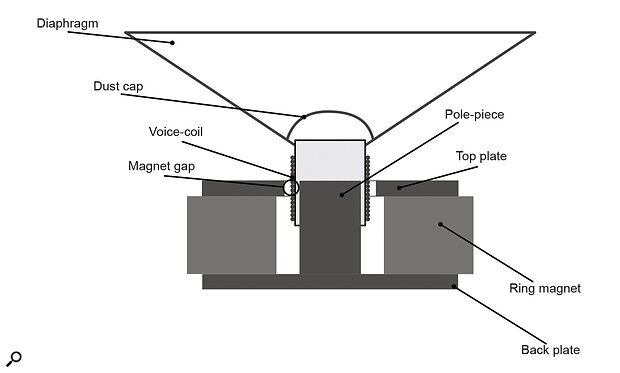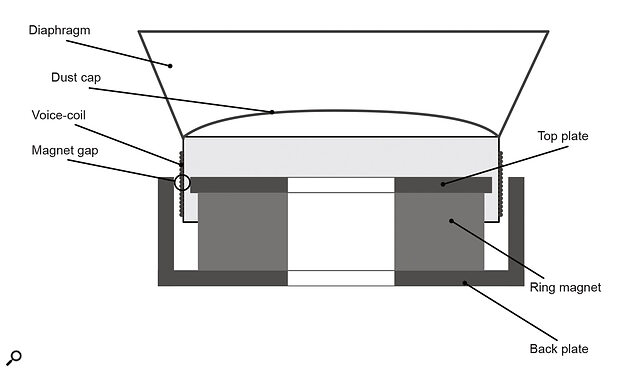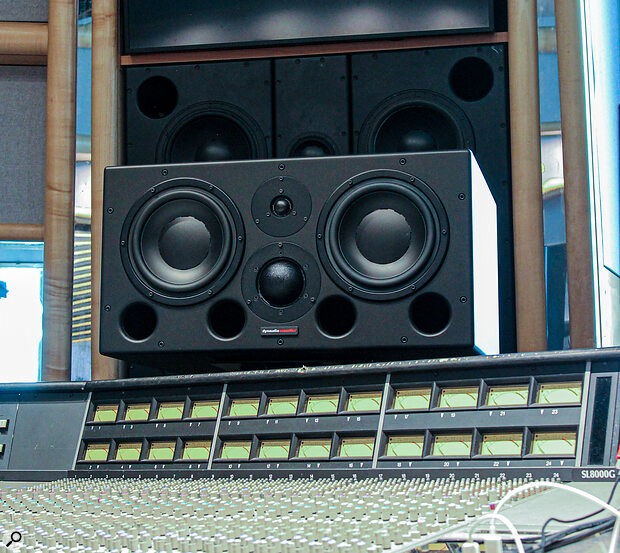We visited AIR Lyndhurst Studios to put the newly revamped M2 monitor through its paces.
Reviewed in the July 2025 issue, the M1 MkII is the entry‑level model in the completely remodelled Dynaudio Acoustics M Series. When the chance arose to experience the new M2 MkII at London’s AIR Lyndhurst Studios, it seemed a great opportunity to find out what an M Series monitor can achieve in a space far larger, and somewhat more luxurious, than my compact studio at home.
While the M1 MkII is a relatively compact two‑way system based around twin 18cm bass/midrange drivers and a 28mm tweeter, the M2 MkII is a significantly more ambitious three‑way system comprising two 24cm MSP (magnesium silicate polymer diaphragm) bass drivers, a 75mm soft‑dome midrange driver and, again, a 28mm tweeter. While the M1 MkII just about falls into the ‘nearfield’ category in terms of its size, low‑frequency bandwidth and maximum SPL capacity, the M2 MkII would be a genuine contender for the main monitor role.
The M2 MkII is primarily designed to be stand‑mounted but could potentially be soffit‑installed, and in contrast to the trapezoidal shape of the M1 MkII, its textured‑finish, 22mm‑panel MDF enclosure is conventionally rectilinear, apart from its softened front edges. The trapezoidal enclosure of the M1 MkII likely offers benefits in terms of suppressing internal acoustic resonance, so why have Dynaudio Acoustics not chosen a similar enclosure shape for the M2 MkII? The reason is likely to be that, being a three‑way system, the main enclosure volume houses only bass drivers, and their low‑pass filtering will occur below the frequencies at which higher internal cabinet resonance might potentially be an issue. The enclosure also incorporates internal panels that brace it and diffuse internal standing waves.
The M2 MkII bass drivers are reflex‑loaded by four flared ports of generous diameter that should offer high levels of laminar airflow. The ports are relatively long, but with low‑pass filtering kicking in at 600Hz, it’s likely that any unwanted organ‑pipe resonance will be above the bass driver’s pass‑band. The ports are tuned to around 38Hz, according to Dynaudio Acoustics monitor designer Phil Pyatt, which ties in pretty well with the M2 MkII’s specified low‑frequency cutoff of 40Hz.
Active Duty
While the M1 MkII is a fully passive design, the M2 MkII is a hybrid of active and passive. Its midrange and high‑frequency drivers are integrated at 4kHz via a passive crossover filter network, while its bass drivers and the midrange/high‑frequency ‘module’ are integrated by active filtering at 600Hz and driven by separate Dynaudio Acoustics DA20 DSP power amplifier channels. The passive MF/HF crossover filtering is achieved using a network of air‑cored inductors and plastic film capacitors that results in nominally second‑order (12dB/octave) filter slopes. The fourth‑order (24dB/octave) active filtering is implemented within the DSP front end of the DA20 amplifier, with the low‑pass‑filtered signal routed to one output channel and the high‑pass‑filtered signal routed to the second output channel.
The fundamental reason for choosing the hybrid active/passive route is that implementing passive crossover filters at relatively low frequencies is always tricky. This is firstly because the large‑value series inductors necessary in a low‑pass filter invariably introduce power‑sapping resistance, and secondly because it’s at lower frequencies that driver input impedance varies most extravagantly, and that makes controlling passive filter slopes problematic. The M2 MkII midrange driver, for example, has its fundamental resonance and significant associated impedance variations between 300Hz and 350Hz; that’s only an octave away from the 600Hz crossover frequency, and would be difficult to manage optimally with passive filtering. Active filters, because they are positioned before the power amplification (and not even in the analogue domain in the case of the M2 MkII), don’t notice driver impedance variations.
Drivers
Although the HF driver is the same Esotar3 unit fitted to the M1 MkII, its implementation is significantly different in the M2 MkII, because rather than working from 1.6kHz upwards, it’s not called upon until 4kHz. This increase in crossover frequency of over an octave will likely be beneficial in terms of high‑frequency distortion and thermal compression, simply because so much less is being asked of the driver. High‑frequency dome drivers, even those like the Esotar3 of slightly larger diameter than the usual 25mm, are typically most stressed at the lower end of their working range, and though the Esotar3 is up there with the best available, restricting its operation to above 4kHz can only be of benefit to the overall performance.
The 4kHz midrange/high‑frequency crossover is of course made possible by the M2 MkII being a three‑way system with a separate midrange driver. Said driver is a 75mm diameter soft‑textile dome that’s unique to the new M Series, although closely related to the one used in the original M Series. That driver had fallen out of use in Dynaudio’s current mainstream hi‑fi and professional product range, and was specifically reintroduced and revised with a neodymium‑iron‑boron magnet for the MkII M Series. The new magnet provides significantly increased sensitivity and consequently reduced thermal compression.
ATC and PMC are well known for their use of dome midrange drivers, and have long argued in favour of the format. There’s also little doubt that the Dynaudio dome is itself a very high‑performance driver, and in much the same way that the development history of the ATC midrange dome stretches back to 1976, Dyanudio’s history with dome midrange drivers is equally long and storied.
The M2 MkII’s bass drivers are similarly invested with some of Dynaudio’s original thinking. In this case it’s the arrangement of the voice coil and magnet — known to speaker engineers as the motor system (a driver is effectively a linear electric motor with a diaphragm stuck to one end). In the vast majority of contemporary moving‑coil bass driver motor systems, a voice coil encircles a steel pole piece with a ceramic magnet, top plate and bottom plate located externally. However, in the original Dynaudio motor system arrangement, a much larger‑diameter voice coil surrounds the entire magnet and top plate assembly. Diagrams 1 and 2 illustrate a conventional and a Dynaudio motor system arrangement.
 Diagram 1: Cross‑section of a conventional driver motor system.
Diagram 1: Cross‑section of a conventional driver motor system.
You’ll see from the diagrams that the Dynaudio‑style motor system enables a much larger‑diameter voice coil than the conventional arrangement, and furthermore results in a very open airflow path directly under the diaphragm dust cap. These are positive attributes for a bass driver. The larger voice‑coil diameter potentially brings significantly higher thermal power handling and reduced susceptibility to thermal compression, and the improved airflow means reduced non‑linear damping. With those two advantages, you might wonder why all motor systems aren’t arranged in Dynaudio style. The answer is that the Dynaudio arrangement is both expensive to manufacture and tends to result in significantly higher moving mass (that big voice coil). More generally, it’s because the design of any driver is the result of balancing a multitude of often conflicting requirements (cost being one), and history has shown that the conventional motor system arrangement more often offers more opportunities to optimise that balance. This is especially the case with drivers required to cover bass and midrange. In the specific bass‑only case of the M2 MkII, the Dynaudio arrangement offers a particularly appropriate set of parameters and performance characteristics.
 Diagram 2: Cross‑section of a classic Dynaudio driver motor system.
Diagram 2: Cross‑section of a classic Dynaudio driver motor system.
The Low Down
Employing a pair of 24cm bass drivers not only enables the M2 MkII to deliver very healthy maximum sound pressure levels and extended low‑frequency bandwidth; it has a further consequence that is probably significant in terms of the way the M2 MkII integrates with room acoustics. The two 24cm bass drivers are spaced about 35cm apart, and work in parallel up to the 600Hz crossover point. Being spaced apart and working up to a frequency where the wavelength is comparable with the spacing means that horizontal off‑axis destructive interference will begin to occur. Imagine, for example, you’re listening at a position 90 degrees off‑axis sideways. The output from the bass driver that’s 35cm further away reaches you around 1ms after the output of the nearer bass driver. One millisecond doesn’t sound very much, but it’s equivalent to half a wavelength at 500Hz. So at 90 degrees off‑axis, the two bass drivers are 180 degrees (half a wavelength) out of phase at 500Hz and their outputs will cancel. There will be a null in the output. But this effect will not just occur at 90 degrees off axis and at 500Hz; the output will begin to cancel at off‑axis angles much less than 90 degrees and at frequencies from, say, 250Hz upwards.
So the M2 MkII, because of its spaced bass drivers working up to 600Hz, will have relatively narrow horizontal dispersion in the all‑important fundamental voice‑band, and that will drive room acoustics rather differently from, say, a portrait‑format monitor with a single bass driver. It will suppress side‑wall reflections and effectively move the transition from the nearfield to the reverberant field back into the room. The generous physical width of the M2 MkII enclosure will also likely result in some horizontal dispersion narrowing into the midrange and high‑frequency bands. In lay terms, the result of all this is that you’ll hear more monitor and less room.
Walking In The AIR
So how does the M2 MkII sound? Listening in the AIR Lyndhurst Studio 2 control room is of course a rather different experience to listening in my home studio with known reference monitors. However, I was able to listen to numerous examples of reference material that I know both inside out and back to front. The M2 MkIIs had been installed by Dynaudio Acoustics, mounted on tall, rigid stands behind the studio’s famous SSL 8000G desk. A small degree of LF boost (1.5dB at 50Hz) had been applied to help optimise the M2 MkII’s performance in the room, but I was able to disable the EQ if I preferred to listen without it (I ended up mostly listening with the EQ enabled, but its effect was pretty subtle).
While my first impressions of a monitor most often revolve around its tonal balance — warm, bright, mid‑emphasis, neutral, and so on — the characteristic of the M2 MkII that initially struck me was its stereo imaging. It produces notably well‑focused images, especially in the voice band of the midrange, with really impressive resolution of depth and space. The stereo focus doesn’t only impress with central images either; panned material also displays a great sense of physical presence. An example of this on one of my reference tracks, Ani DiFranco’s ‘Little Plastic Castles’, is in its horn section. The horns predominantly appear panned generally left and right in the stereo image, but I’d never quite been as much aware of the acoustic space around them as I was on the M2 MkII at AIR. I listened to it quite a few times.
Moving away from stereo imaging, the M2 MkII displays a generally neutral tonal balance with perhaps a hint of midrange emphasis. I suspect the midrange emphasis might be a consequence of the M2 MkII’s likely narrower horizontal dispersion and the way it drives the listening room — it perhaps generates a smidgeon less low‑mid energy at the listening position, and that results in a slight subjective upper‑midrange prominence. Whatever its cause, the midrange emphasis is far from a significant negative because it is not associated with any deeper distortion or resonance issue, and is very easy to learn. It also reveals the fabulous inherent quality of the midrange driver, and it works pretty well in a mix context because, in a slightly Yamaha NS10 style, it makes important midrange mix elements a little more explicit. If that’s not required, the midrange balance could be easily tweaked with a little EQ applied via the power amplifier amp.
At the low end of the spectrum, the M2 MkII worked extremely well in the AIR Studio 2 control room. It combines good low‑frequency extension, commensurate with a main monitor role, with very satisfying dynamic precision, but the characteristic that I found most interesting was its accuracy of low‑frequency pitch. Speakers of all types, be they pro monitors or hi‑fi models, sometimes find low‑frequency pitch accuracy difficult. The issue is that music extends to the same low frequencies as electro‑acoustic resonances (driver, enclosure, reflex port), and if these are poorly handled they can, to some degree, mask the input signal pitch. It’s a phenomenon not dissimilar to ‘wolf tones’ in stringed instruments, where a body (or, more usually, a neck) resonance can dominate over the pitch of an adjacent note.
Back to the M2 MkII, I think its low‑frequency pitch accuracy arises thanks to a number of factors. Firstly, it’s not too greedy of low‑frequency bandwidth, so its inherent electro‑acoustic resonances don’t dominate the subjective bass character. And secondly, it is blessed with generous bass driver diaphragm and reflex port area, so at sensible listening levels, neither are driven into non‑linear regions where they are less able to follow the input signal accurately.
I wrote about the subjective quality of the Mk2 MkII Esotar3 tweeter back in my M1 MkII review and nothing has changed here. These things are impossible to be definitive about, but I don’t think I’ve heard many, if any, other tweeters do the trick of presenting extraordinary levels of detail while simultaneously not drawing attention to themselves quite so well as the Esotar3. It’s a hugely valuable quality in a monitor because it really helps enable reliable judgement of, for example, vocal intelligibility and sibilance. If either sounds like an issue, you can be pretty sure it’s not the tweeter fooling you.
I was struck by just how much new detail I was hearing and how much mix insight and perspective the M2 MkII was offering.
I had a truly enjoyable time listening to the M2 MkII in the AIR Studio 2 control room, and my choice of material relatively quickly became one driven by entertainment as much as it was by monitor analysis. Enjoyment, however, is hardly the point. Monitors are designed to do a job, not to indulge Sound On Sound reviewers. But even while I was listening to both favourite tracks and reference tracks that help me understand a monitor (these are not always the same), I was struck by just how much new detail I was hearing and how much mix insight and perspective the M2 MkII was offering. The M2 MkII is a superb monitoring solution that, like the M1 MkII, demonstrates that, even in our contemporary world of DSP solutions to everything, traditional skill and understanding in electro‑acoustic engineering and design can still get the job done remarkably well.
Alternatives
The M2 MkII is not an inexpensive monitoring solution and is up against some similarly high‑performance products: the ATC SCM45A, PMC 8‑2, PSI A25‑M, Kii Three, Dutch & Dutch 8C and Amphion One25A spring to mind.
Pros
- Really impressive, informative bass.
- Dispersion characteristic helps with room acoustics.
- Fabulous midrange driver.
- The bass drivers and tweeter aren’t bad either.
Cons
- None.
Summary
My second experience of the new MkII M Series was as rewarding as the first. The M2 MkII is a fine monitor that deserves serious consideration.
Information
£12,000 per pair including amplification.
Synthax Audio +44 (0)1727 821870.
£12,000 per pair including amplification.
Dynaudio North America +1 847 730 3280.

